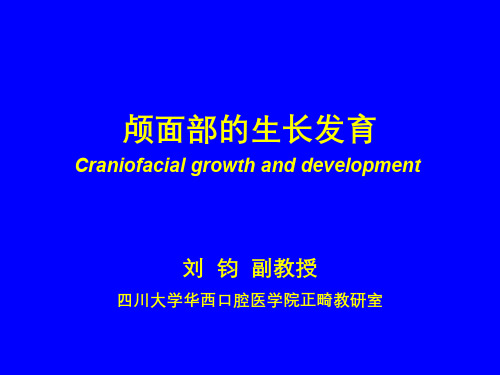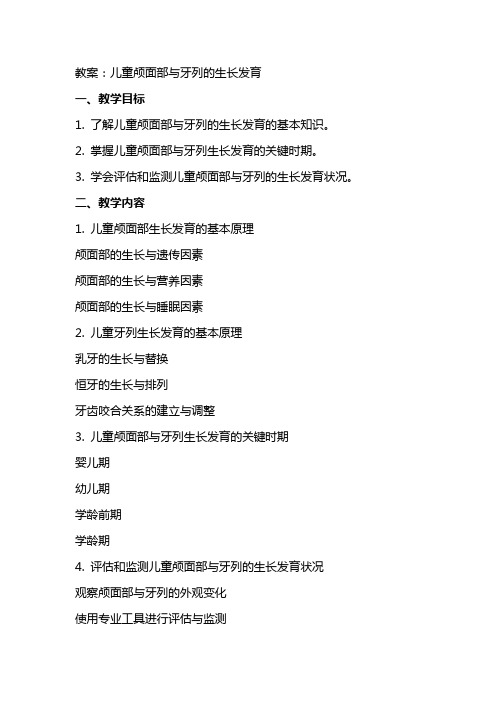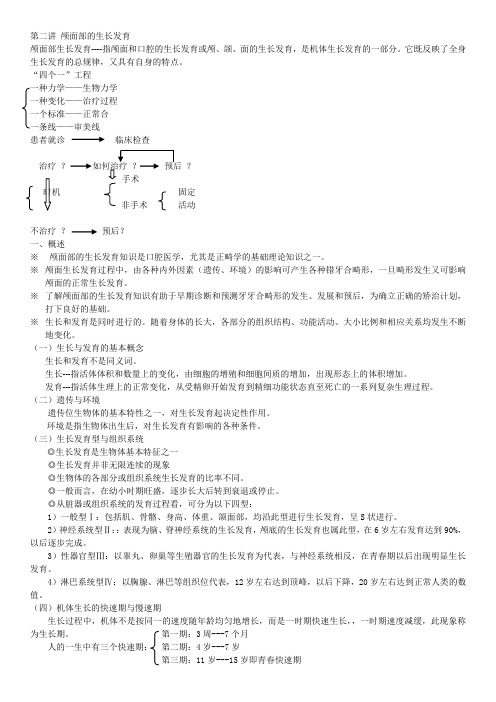颅面部生长发育
颅面部生长发育

营养因素
蛋白质:影响颅面部生长发育的 重要因素之一
碳水化合物:提供能量,参与骨 骼和牙齿的发育
脂肪:对颅面部肌肉和神经系统 的发育至关重要
维生素和矿物质:缺乏会导致生 长发育障碍和畸形
添加副标题
颅面部生长发育
目录
C生长发育的影响因素
颅面部生长发育的基 本特点
生长特点
协调生长:各部分结构按比 例生长,保持面部比例协调
早期生长:颅面部结构在胎 儿期和婴儿期生长迅速,青
春期后逐渐减缓
连续生长:颅面部各部分结 构持续生长,直至成熟
遗传因素:颅面部生长发育 受遗传因素影响较大
发育特点
生长发育阶段: 可分为胎儿期、 婴儿期、儿童期、 青少年期和成人 期
影响因素:遗传、 环境、生活习惯 等
生长发育评估指 标:头围、面高、 眼距等
发育阶段特点: 胎儿期受母体影 响较大,婴儿期 头颅骨缝未闭合, 儿童期面部发育 变化大,青少年 期面部轮廓基本 形成,成人期面 部特征稳定
颅面部生长发育的影 响因素
遗传因素
影响因素:基因、染色体异 常等
研究意义:为颅面部生长发 育异常的病因提供重要依据
定义:指来自父母遗传的生 物特征
临床意义:指导医生对颅面 部生长发育异常进行诊断和
治疗
环境因素
遗传因素:影响颅面部生长发育的主要内在因素 营养因素:母体营养及婴儿喂养对颅面部发育有影响 疾病因素:影响颅面部生长发育的疾病有很多 生活习惯:不良的口腔习惯和面部表情肌的使用对颅面部发育有一定影响
颅面部的生长发育

以说是颌面部生长的遗传表现型 2 )同一个体,不同年龄阶段,面部生长型基本是一致的,有其
连续性
10
凹面型
直面型
凸面型
面部生长型侧面观分类
11
面部生长型的遗传性
Comptemporary Orthodontics (4th edition)
• 研究表明,生长中心大部分由透明软骨组成,如颅 底的软骨联合、长骨的骺软骨、鼻中隔软骨 • 这些软骨的生长方式都是间质生长,或称软骨内生 长,是通过软骨内软骨细胞的长大和分裂,进而不断 地产生基质和纤维,使软骨从内部生长增大
24
生长中心( growth center )
25Hale Waihona Puke ** 生长区与生长中心的区别
发育是涉及生长的一系列阶段,包含形态的 形成、分化和生理上功能的获得和成熟
5
* 生长型( growth pattern )
人体从婴儿到成人各组织器官体积大小比例在三维 空间的变化
包括以下三方面的含义:
1 . 生长型是反映身体各部分在生长发育过程中 ,空间比例关系的变化
2 . 正常生长型的另一表现为身体所有组织、器 官、系统按其生理需要,生长的速率不一致
7. 生长中心( growth center )
3
* 生长( growth )
活体在生命的过程中数量和大小上的正常变 化,是直接或间接的细胞分裂数目增加、细 胞间质增长的结果
生长是量、大小的变化
4
* 发育( development )
活体生理上的正常变化,即活体从受精卵开 始发展到精细的多功能状态的一系列复杂的 不可逆的生理过程
教案:儿 童 颅面部与牙列的生长发育

教案:儿童颅面部与牙列的生长发育一、教学目标1. 了解儿童颅面部与牙列的生长发育的基本知识。
2. 掌握儿童颅面部与牙列生长发育的关键时期。
3. 学会评估和监测儿童颅面部与牙列的生长发育状况。
二、教学内容1. 儿童颅面部生长发育的基本原理颅面部的生长与遗传因素颅面部的生长与营养因素颅面部的生长与睡眠因素2. 儿童牙列生长发育的基本原理乳牙的生长与替换恒牙的生长与排列牙齿咬合关系的建立与调整3. 儿童颅面部与牙列生长发育的关键时期婴儿期幼儿期学龄前期学龄期4. 评估和监测儿童颅面部与牙列的生长发育状况观察颅面部与牙列的外观变化使用专业工具进行评估与监测及时发现并处理生长发育问题正确的刷牙方法定期进行口腔检查合理饮食与口腔健康三、教学方法1. 讲授法:讲解儿童颅面部与牙列生长发育的基本原理、关键时期和评估方法。
2. 演示法:展示儿童颅面部与牙列生长发育的图片和模型,帮助学生更直观地理解。
3. 实践操作法:学生分组进行模拟评估和监测,互相练习,提高实际操作能力。
四、教学评价1. 课堂参与度:评估学生在课堂上的发言和提问情况,了解学生的学习积极性。
2. 小组讨论报告:评估学生在小组讨论中的表现和提出的建议,了解学生的理解和思考能力。
3. 实践操作评估:评估学生在模拟评估和监测中的操作技能和知识应用能力。
4. 课后作业:评估学生对课堂内容的掌握情况,巩固学习成果。
五、教学资源1. 教材:儿童颅面部与牙列生长发育的相关教材或指导书籍。
2. 图片和模型:展示儿童颅面部与牙列生长发育的图片和模型。
3. 视频资料:播放儿童颅面部与牙列生长发育的相关视频,帮助学生更直观地理解。
4. 实践操作工具:提供模拟评估和监测所需的工具,如口腔检查器械等。
六、教学活动安排1. 教学活动一:讲解儿童颅面部生长发育的基本原理(20分钟)讲解颅面部的生长与遗传因素、营养因素和睡眠因素的关系。
2. 教学活动二:讲解儿童牙列生长发育的基本原理(20分钟)讲解乳牙的生长与替换、恒牙的生长与排列以及牙齿咬合关系的建立与调整。
颅面部生长发育特点

颅面部生长发育特点颅面部生长发育是指人类头部和面部骨骼的生长和发育过程。
它是一个复杂的过程,涉及多个骨骼和软组织结构的生长和变化。
在人类的整个生命周期中,颅面部的生长发育一直在进行,从出生时到成年后,颅面部的形态和结构都会发生显著的变化。
颅面部生长发育的特点主要包括以下几个方面:1. 生长速度逐渐减慢:在人类的发育过程中,颅面部的生长速度是逐渐减慢的。
在出生后的几个月内,颅面部的生长速度非常快,但随着年龄的增长,生长速度逐渐减慢,直到成年后基本停止。
这种减慢的生长速度使得颅面部能够适应身体其他部位的发育变化。
2. 骨骼和软组织的协调生长:颅面部的生长发育是骨骼和软组织的协调生长过程。
在颅骨和面骨的生长过程中,软组织如肌肉、皮肤等也会随之生长,以适应骨骼的形态变化。
这种协调生长使得颅面部能够保持正常的功能和外貌。
3. 骨骼的骨化过程:在颅面部生长发育过程中,骨骼的骨化是一个重要的过程。
在胎儿期和婴幼儿期,颅面部的骨骼主要是软骨组织,随着年龄的增长,软骨逐渐骨化,形成成人颅面部的骨骼结构。
这个骨化过程是一个逐渐进行的过程,在不同的部位和时期有不同的速度和方式。
4. 面部特征的形成:颅面部的生长发育过程中,面部特征的形成是一个重要的方面。
面部特征包括眼睛、鼻子、嘴巴等部位的形态和位置。
在颅面部生长发育过程中,这些面部特征会逐渐形成,并且与其他部位的生长发育相互作用。
面部特征的形成不仅受到遗传因素的影响,还受到环境和生活方式等多种因素的影响。
5. 面部比例的变化:随着年龄的增长,颅面部的比例会发生变化。
在婴幼儿期,颅骨相对较大,面部相对较小,随着年龄的增长,面部逐渐发育,与颅骨的比例逐渐接近成人。
这种比例的变化使得颅面部能够适应身体其他部位的发育变化。
总的来说,颅面部生长发育是一个复杂的过程,涉及多个骨骼和软组织结构的生长和变化。
它具有生长速度逐渐减慢、骨骼和软组织的协调生长、骨骼的骨化过程、面部特征的形成以及面部比例的变化等特点。
正畸学习题-第二章 颅面部的生长发育

第二章颅面部的生长发育教学内容和目的要求1.教学内容生长发育的基本概念;出生前以及出生后颅面的生长发育;上下颌骨的发育;牙列和牙合的发育。
2.目的要求了解颅颌面生长发育与牙颌面防治的关系;掌握判断青春期的方法,青春期对牙颌畸形矫治的意义;区别诊断暂时性畸形、牙源性畸形与骨性畸形。
二.重点(1)生长发育的基本概念。
(2)颌面部的增长快速期。
(3)青春期预测方法。
2.难点(1)生长区与生长中心的概念(2)下颌骨的生长旋转。
(3)生长型的概念和分类。
【名词解释]1.生长型 Growth pattem2.垂直生长型Ver ticalgrwthpattem 3.水平生长型HorizponalgrowthPattern4.平均生长型Average ofgrowthpattern5.面部生长型Patternof f acialgrowth6.生长区Growthsite7.生长和发育Growt h anddevelopment8.生长时间Growtdtimingn 9.生长中心Growthcenter10.生长变异Growth variability11.Hellman牙龄IIIA12.Hellman牙龄III C13,Hellman牙龄IVA[A型题]14.常用的颅面分界线有A.1个B.2个C.3个D.4个E.5个15.颅底平面是指A.SN平面B.FH平面C.N—Bolton平面D.N-Ba平面E.以上均不对16.6岁儿童脑、脊神经系统的生长发育可达到成人的A.40%B.50%C.60%D.90%E.80%17.颅部和面部的容量比在出生时是A.8:IB.6:IC.4:1D.2:IE.1:118.颅部和面部的容量比在成人时是A.8:IB 6:IC4:1D.2:1 E.1:119.下面宽(下颌角间距),在第一恒磨牙萌出时期已完成A.70%B.75%C.80%D、85%E.90%20.出生时钙化的软骨结合为A.蝶筛软骨结合B.蝶颈软骨结合C.蝶骨间软骨结合D.蝶枕软骨结合E.颧筛软骨结合21.出生后面部的生长发育,长度、宽度和高度的增长,哪一项幅度最大A.长度B.宽度C.高度D.三者相同E.以上均不对22.一般认为面下部的深度增加1mm时,相对地面中部的深度增加为A.0.4mm B.0、6mm C.0、8mmD.1.0mmE.1.2mm23.有关面部生长发育的预测,下列说法错误的是A.以一些群体研究调查结果的测量值而得出的平均值,并非每个个体都适合B.对于每个个体面部的生长量和方向,现已能准确预测C.面部生长发育的预测,将有助于诊断和治疗设计D.不同的地区、种族,应有不同的生长发育预测值E.目前,对于个体发育预测多使用某一年龄阶段的测量平均值来进行预测分析24.关于上颌骨的生长发育,下列说法错误的是A.上颌骨由第一鳃弓的上颌突、侧鼻突和中鼻突共同发育而成B.上颌骨主要是向下、向前及向外生长C.上颌骨的唇侧吸收陈骨,舌侧增生新骨D.上颌结节后壁区增生新骨,增加上颌骨长度E.腮骨后缘有新骨增生,使长度增加25.下列关于下颌骨宽度的增长,正确的是A.下颌骨的外侧面吸收陈骨,内侧面增生新骨B.髁突随颈下颌关节凹向侧方生长,可使下颌支宽度增加C.下颌骨前部在乳牙萌出后,宽度增加较多D.下颌尖牙间宽度在11岁以后还会增加E.以上均不正确26.关于颏部生长,下列说法错误的是A.灵长类中只有人才具有颏B.颏部的突出是由于颏的基底部和牙根尖部附近骨的增生C.颏隆起,从正畸学来讲,对侧貌外形具有较大的意义D.颏在尖牙牙槽附近为增生,向内侧移动E.当颏结节部突出时,即使上颌前牙少许突出一点,侧面外貌还是和谐的27.由婴儿到成人,腭顶高度逐渐增加的原因是A.腭盖的表面增生新骨及鼻腔底面吸收陈骨B.腭盖的表面吸收陈骨及鼻腔底面增生新骨C.牙糟突的生长速度小于腰盖升高速度D.牙槽突的生长速度大于腰盖降低速度E.以上均不正确28.面颌肌肉的动力平衡中,与向后的动力有关的主要肌肉是A.颁肌B.翼外肌C.翼内肌D.咬肌E.唇肌29.上颌乳尖牙的近中和远中出现间隙称为A生长间隙B、灵长间隙C.替牙间隙D.可用间隙E.必须间隙30.正常乳牙牙合的特征是A.有剩余间隙‘B.乳尖牙为远中关系C.前牙覆盖深D.终末平面以垂直型及远中型为多E.以上均不正确31.不属于恒牙正常萌出顺序的是A.上颌:6—1—2-4——5—3—7B.上颌:6-1—2-4一3-5—7C.下颌:6—1—2-4—3—5—7D.上颌:6—l—2-3-4-5—7E.下颌:6—1—2—3—4—5—732.替牙期间的暂时性错牙合是A.多余牙导致上颌左右中切牙萌出早期,出现间隙B.上下恒切牙萌出早期可出现前牙反牙合C.上颌侧切牙初萌时,牙冠向近中倾斜D.上下颌第一恒磨牙建牙合初期,为远中牙合关系E,恒切牙萌出初期,出现轻度拥挤33.属于替牙期间的暂时性错牙合是A.恒前牙反牙合B.恒前牙萌出时出现中度拥挤C.前牙开牙合lmmD.上下恒切牙萌出早期,出现前牙深覆牙合E.上下颌第一恒磨牙建牙合初期,远中牙合关系34.Hellman将牙齿的发育进度分为几期A.4B.5 C.6D.7E、935.乳磨牙脱落、后续前磨牙开始萌出期为A.IIAB.IIC C、IIIAD.IIIBE.IIIC36第一恒磨牙开始萌出期为A、IIAB、IIC C、IIIAD、IIIBE、IIIC37.20岁的正常牙合成年人下颌角一般为A、100°~110°B、120°一130° C、130~140°D、140°~150°E、150°~160°38.由新生儿到成人,上颌骨的长度增长约为A.1.0倍B.1.5倍 C 2、0倍D,2.5倍E.3.0倍39.有关替牙间隙的作用及意义,下列说法正确的是A.上颌的替牙间隙大于下颌的替牙间隙B.替牙间隙在下颌单侧约有0.9—lmmC.乳磨牙脱落后,上颌第一磨牙近中移动较下颌第一磨牙为多D.乳磨牙终末平面为垂直型的,不能建立恒磨牙的中性关系E.以上均不正确[X型题]40.关于生长的概念,下列正确的有A.生长是指体积的增加B.生长是指数量的增加C.生长指组织增长的程度,表现为细胞脏器功能上的分化和完成的过程D.由细胞的增殖和细胞间质的增加,出现形态上的体积增大E、生长和发育密切相关,实际上是同一个概念41.关于遗传和环境,下列描述中不正确的有A.遗传是生物体的基本特性之一,在亲代子代之间存在着形态和结构上的相似点B.遗传就是亲子代的完全相同C.遗传对生长发育起决定作用D.环境是指生物体出生后对生长发育有影响的各种条件E,季节、生活方式等不属于环境因素42.颅面部生长发育的研究方法A.人体测量法B.种植体法C.放射性同位素法D.组织切片法E、x线头影测量法43.关于面部的生长发育,正确的描述有A.出生时面部以宽度最大,但出生后的增长以高度最大,深度次之,宽度最少B.面高度后部比前部增加量小C.面宽度与牙弓宽度间有相关关系D.与正畸学关系较大的是面深度E.面下部较面中部增长较多,面中部又较面上部增加较多,这是面部生长发育的一个重要原则44.请指出以下生长阶段中,哪些属于生长快速期A 出生5、6岁 B、5、6岁女性10岁左右C、女性10岁左右女性14—16岁男性12岁左右男性12岁左右男性16—18岁D、女性14~16岁女性18~20岁左右男性16~18岁男性24岁左右E、女性18-20岁女性左右发育完成男性24岁左右45,颅面骨骼的发育方式有以下几种A.骨缝的间质增生B.软骨的间质增生C.软骨的表面增生D.骨的间质增生E.骨的表面增生46.婴儿颅面部的主要透明软骨分布区集中在A.颅中部B.颅底部C眶部D.鼻部E.下颌髁突软骨之表面47.常用的颅面分界平面有A.面横平面B.颅底线(平面)C.左右眶下缘最低点至左右外耳道下缘最低点的连线所形成的一个平面D.Frankfort平面E.Bolton_鼻根点平面48.颅底软骨结合包括A.蝶筛软骨结合B.蝶颞软骨结合C.蝶骨间软骨结合D.筛颞软骨结合E.蝶枕软骨结合49.面颌肌肉的动力平衡中,与向前动力有关的肌肉是A.颈肌B.翼外肌C.翼内肌D.咬肌E.唇肌【填空题]50、——对生长发育起决定性作用。
2 颅面部的生长发育

第二讲颅面部的生长发育颅面部生长发育----指颅面和口腔的生长发育或颅、颌、面的生长发育,是机体生长发育的一部分。
它既反映了全身生长发育的总规律,又具有自身的特点。
“四个一”工程一种力学——生物力学一种变化——治疗过程一个标准——正常合一条线——审美线患者就诊临床检查治疗??手术固定非手术活动不治疗?预后?一、概述※颅面部的生长发育知识是口腔医学,尤其是正畸学的基础理论知识之一。
※颅面生长发育过程中,由各种内外因素(遗传、环境)的影响可产生各种错牙合畸形,一旦畸形发生又可影响颅面的正常生长发育。
※了解颅面部的生长发育知识有助于早期诊断和预测牙牙合畸形的发生、发展和预后,为确立正确的矫治计划,打下良好的基础。
※生长和发育是同时进行的。
随着身体的长大,各部分的组织结构、功能活动、大小比例和相应关系均发生不断地变化。
(一)生长与发育的基本概念生长和发育不是同义词。
生长---指活体体积和数量上的变化,由细胞的增殖和细胞间质的增加,出现形态上的体积增加。
发育---指活体生理上的正常变化,从受精卵开始发育到精细功能状态直至死亡的一系列复杂生理过程。
(二)遗传与环境遗传位生物体的基本特性之一,对生长发育起决定性作用。
环境是指生物体出生后,对生长发育有影响的各种条件。
(三)生长发育型与组织系统◎生长发育是生物体基本特征之一◎生长发育并非无限连续的现象◎生物体的各部分或组织系统生长发育的比率不同。
◎一般而言,在幼小时期旺盛,逐步长大后转到衰退或停止。
◎从脏器或组织系统的发育过程看,可分为以下四型:1)一般型Ⅰ:包括肌、骨骼、身高、体重、颌面部,均沿此型进行生长发育,呈S状进行。
2)神经系统型Ⅱ::表现为脑、脊神经系统的生长发育,颅底的生长发育也属此型,在6岁左右发育达到90%,以后逐步完成。
3)性器官型Ⅲ:以睾丸、卵巢等生殖器官的生长发育为代表,与神经系统相反,在青春期以后出现明显生长发育。
4)淋巴系统型Ⅳ:以胸腺、淋巴等组织位代表,12岁左右达到顶峰,以后下降,20岁左右达到正常人类的数值。
颅颌面生长发育

均衡饮食
保证婴幼儿获得充足的营 养,特别是钙、磷等矿物 质和维生素D,以促进骨 骼的正常生长。
颅颌面生长发育的治疗方法
颅颌面矫形器
对于轻度的颅颌面畸形,可以使用颅 颌面矫形器进行早期干预,通过逐渐 调整面部骨骼的形态,改善面部对称 性和轮廓。
正畸治疗
外科手术
对于严重的颅颌面畸形,可能需要进 行外科手术,通过手术方法调整面部 骨骼的位置和形态,以达到改善面部 美观和功能的目的。
颅颌面生长发育
汇报人:可编辑
2024-01-11
CONTENTS
• 颅颌面生长发育概述 • 颅颌面的结构与功能 • 颅颌面的生长异常与畸形 • 颅颌面生长发育的干预与治疗 • 颅颌面生长发育的研究进展
01
颅颌面生长发育概述
颅颌面的定义与特点
颅颌面是人体头面部的重要组成部分 ,包括颅骨、上颌骨、下颌骨以及附 着在它们上面的肌肉、牙齿和软组织 等。
下颌骨生长异常与畸形
01
02
03
下颌发育不良
下颌骨生长速度过慢,导 致下颌后缩或下颌过小。
下颌畸形
下颌骨在生长过程中未能 正常发育,形成各种下颌 畸形,如下颌前突、下颌 后缩等。
下颌肿瘤
下颌骨内生长的良性或恶 性肿瘤,可导致下颌骨变 形、破坏和功能障碍。
面部软组织生长异常与畸形
面部肌肉萎缩
面部肌肉因各种原因导致萎缩,影响面部 形态和功能。
面部软组织的发育和生长对美 观和表情表达具有重要影响, 如皮肤质地、皱纹形成等。
颅颌面肌肉的结构与功能
颅颌面肌肉主要包括咀嚼肌和表情肌,主 要功能是实现咀嚼和表情动作。
咀嚼肌包括咬肌、颞肌、翼内肌、翼外肌 等,能够实现咀嚼食物时的咬合动作。
颅颌面生长发育课件

3
青春期
颅颌面生长迅速,牙齿换牙和垂直生长达到顶峰。
颅颌面生长异常的常见类型
开颌畸形
下颌骨过长或上颌骨过短,导致口腔无法正常 关闭。
唇腭裂
颅颌面发育不完整,导致唇裂和腭裂的形成。
智齿不正常生长
智齿可能没有足够的空间生长,导致疼痛和其 他口腔问题。
牙齿拥挤
牙齿之间的空间不够,导致拥挤和不正常的咀 嚼功能。
诊断和治疗方法
通过影像学检查、骨骼测量和牙齿模型等方法来诊断颅颌面生长异常,并采 取相应的治疗方案,如矫正器、手术或保守治疗。
结论和要点
颅颌面生长发育对个体的外貌和功能至关重要,了解其定义、结构、影响因素以及常见异常类型对于诊断和治 疗都是必要的。
颅颌面生息对颅颌面 发育有重要影响。
2 环境因素
营养、生活习惯和环境刺 激等都会对颅颌面生长产 生影响。
3 功能因素
颅颌面的功能需求也会影 响其生长发育。
颅颌面生长发育的几个阶段
1
胚胎期
颅颌面最初的发育阶段,骨骼和口腔结构开始形成。
2
儿童期
颅颌面的骨骼和牙齿逐渐发育成熟,面部外貌开始成型。
颅颌面生长发育ppt课件
本课件将介绍颅颌面生长发育的重要性和定义,解析其结构和功能,探讨影 响因素,阐述不同阶段以及常见异常类型,以及诊断和治疗方法。最后给出 结论和要点。
发育的定义和重要性
发育是生物体从生命开始到成熟的过程,颅颌面生长发育在个体的外貌和功 能方面至关重要。
颅颌面的结构和功能
颅颌面包括骨骼、牙齿和软组织等结构,它们共同构成了颅颌面的功能,如 咀嚼、言语和吞咽。
- 1、下载文档前请自行甄别文档内容的完整性,平台不提供额外的编辑、内容补充、找答案等附加服务。
- 2、"仅部分预览"的文档,不可在线预览部分如存在完整性等问题,可反馈申请退款(可完整预览的文档不适用该条件!)。
- 3、如文档侵犯您的权益,请联系客服反馈,我们会尽快为您处理(人工客服工作时间:9:00-18:30)。
关节部的生长与改建
◆ 髁突向后上方生长,形
成头大颈小的形态;
◆ 髁突的位置根据V字形
原理,向V字开阔的侧方 生长。 髁状突的生长
(Goose,DH,1982)
髁状突软骨的作用
Severe
mandibular
deficiency from TMJ infection.
颏部的生长
◆
灵长类中只有人类具有颏的特征;
The remodelling mechanism involved in this superior and lateral relocation is basically the expanding “V” principle. As the coronoid termini become higher, they grow apart at their apicies.
Mandible symphysis closes 1-2 years.
下颌骨的三向生长
生长方式: ◆髁突软骨成骨 ◆骨膜下的骨表面增生
The mandible is a composite bone with endochondral growth at the condyle and intramembranous bone formation.
Most common eruption sequence:
上:6-1-2 -4-5-3-7 -8 下:6-1-2 -3-4-5-7 -8
5-8.5 yrs. early mixed dentition 9-13 yrs. late mixed dentition 18-25yrs
Another sequence of eruption fairly common in the mandibular arch is:
◆ 终末平面以垂直型及近中型较多,对恒牙合的
建立意义较大;
◆ 上颌乳尖牙的近中舌侧面与下颌乳尖牙的远中
唇侧面相接触。
(二)替牙合期
6-12岁,“丑小鸭”阶段
Period when both primary and permanent teeth are present in the
mouth.
恒牙萌出时间及顺序
下颌骨宽度的增长
◆下颌骨外侧面增生新 骨,内侧面吸收陈骨; ◆髁突随颞凹向两侧生长,使 升支宽度增加; ◆下颌骨前部在乳牙萌出后, 宽度较少增加,下颌尖牙间 宽度在11岁以后几无增加。
下颌骨高度的增长
◆ 下颌升支高度的生长主
◆ The mandibular condyleEndochondral growth by interstitual and appositional proliferation of cartilage
终末平面的类型
◆ 垂直型(flush terminal plane) ◆ 近中型(mesial step) ◆ 远中型(distal step)
正常乳牙合的特征
2-4岁 4-6岁 无间隙、无磨耗、E远中呈直线 有间隙、有磨耗、E 近中移动
正常乳牙合的特征
◆ ◆ 前牙合关系:覆盖很浅,覆合较深; 前牙部分具有生长间隙及灵长间隙;
下颌骨的三向生长
◆ 长度的增长
◆ 宽度的增长
◆ 高度的增长
下颌骨各部分的生长方向
(Enlow,DH,1990)
下 颌 骨 长 度 增 长
◆ 下颌升支前缘吸收陈 骨、后缘及外侧增生新骨; ◆ 下颌骨外侧增生新骨、内 侧吸收陈骨; ◆ 下颌骨的增长,以磨牙区 为最多,由第二乳磨牙至下颌 角的距离,在新生儿约为 10mm,6岁时约20mm, 成人约45-50mm。 ◆ Posterior border of ramusintramembranous bone formation by periosteal tissues. Simultaneous resorption of bone on the anterior border of ramus. ◆ Surface deposition and reposition on complete surface of mandibular- remodelling. ◆ Mandibular lingual tuberosity (intramembranous)-appositional growth for horizontal elongation of the mandibular body on the lingual surface(between most posterior molar and mandibular foramen)
Class I relationship. (ii) Straight(Flush) terminal plane: erupting lower first permanent molars may give mesial force moving lower second primary
molars forward to allow a Class I molar relation.
下颌升支肌肉附着处的横 断面(Enlow, D.H.1990)
Vertical section through the ramus and the coronoid process showing the charateristic pattern of resorption
下颌支向侧方 扩大,“V” 字形原理
◆ A backward transposition of the ramus, thereby permitting elongation of the body of the mandible. ◆ A displacement of the body (and dentition) in an anterior direction. ◆ A vertical lengthening of the ramus, providing
或为:上:6-1-2 -4-3-5-7 -8 下:6-1-2 -4-3-5-7 -8
The sequence of eruption of the permanent teeth is more important than the exact time of eruption.
Eruption of the first permanent molars
The mandible appears to “grow” in a downward and forward manner when visualized on superimposed serial cephalometric tracing registered on cranial base. A: Simultaneous displacement occurs in the opposite direction, displacing the chin anteriorly and inferiorly. B: Actual growth takes place in a wide variety of regional direction with the predominent growth trend posteriorly and superi◆ 颏部对侧面外形具有重要意义。
四、牙列与合的发育
(一)合的建立
◆ 婴儿在无牙齿萌出时,无合关系;
◆ 婴儿第6个月乳牙萌出时开始建合;
◆ 成人第三磨牙萌出时才完成建合。
(二)建合的动力平衡(肌肉)
◆ 向前的动力 ◆ 向后的动力 ◆ 内外的动力平衡 ◆ 垂直向的动力平衡
Gives the key to the occlusion
Three ways a Class I molar relationship can develop:
(i) Mesial step terminal plane: permanent molars erupt directly into a
下颌骨的生长发育
The Growth and Development of Mandible
口腔正畸学教研室 刘月华
Department of Orthodontics Liu Yuehua, DDS, PhD, M.Orth.RCS(Edin)
下颌骨的发生(Sperber,GH, 1989)
Three major parts: body, rami, alveolar process
(iii) Late mesial shift of a straight terminal plane. -most common way that a Class I molar relation results. -permanent molars erupt end-to-end. -because of dimensional differences between the primary and permanent 3,4 and 5(Leeway space of Nance), after exfoliation of the primary teeth the lower first permanent molars move mesially
要靠下颌髁突新骨的生长; ◆ 喙突的同时生长;
◆ 下颌体的生长,主要是靠 ◆ Surface deposition and resorption on complete 下颌牙齿萌出时牙槽突的增高 surface of mandibular-remodelling 及下颌骨下缘少量增生新骨。 inferior border of mandible
displacement of the mandible inferiorly and vertical
dimension for alveolar growth. ◆ A moveable articulation during various growth
